Kenmore 11027132413, 11027132412, 11027132411, 11027132410, 11026134610 Owner’s Manual
...
Use & Care Guide Manual de uso y cuidado
Guide d’utilisation et d’entretien
English / Español / Français
Table of Contents...2 / Índice...20 / Table des matières...41
Designed to use only HE High Efficiency detergents.
Diseñada para utilizar solamente detergentes de alto rendimiento (HE).
Conçue pour l’utilisation d’un détergent haute efficacité seulement.
Models/Modelos/Modèles: 110.26132410, 110.26132411, 110.26132412, 110.27132410, 110.27132411, 110.27132412, 110.26134610, 110.26134611
Kenmore®
Top-Loading High Efficiency Low-Water Washer
Lavadora de carga superior, de alto rendimiento y con nivel bajo de agua
Laveuse haute efficacité à faible consommation d’eau avec chargement par le dessus
P/N W11040356A
Sears Brands Management Corporation
Hoffman Estates, IL 60179 U.S.A.
www.kenmore.com
Sears Canada Inc.
Toronto, Ontario, Canada M5B 2C3
www.sears.ca
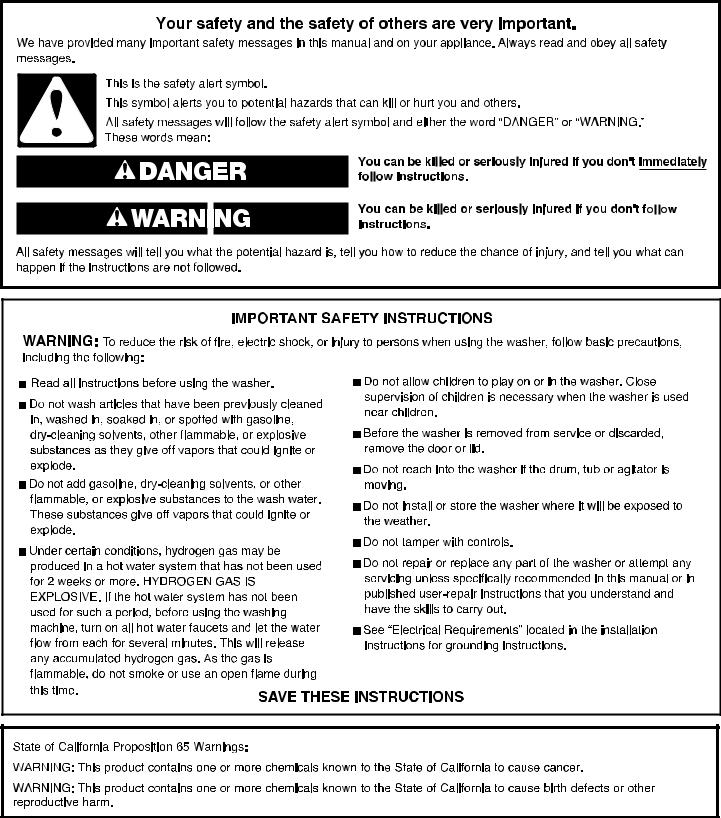
TABLE OF CONTENTS
WASHER SAFETY 2 WHAT'S NEW UNDER THE LID? 3
CONTROL PANEL AND FEATURES 4 Dispensers 6
CYCLE GUIDE 7 USING YOUR WASHER 9
WASHER MAINTENANCE 12 TROUBLESHOOTING 14 PROTECTION AGREEMENTS 19 WARRANTY 19 ASSISTANCE OR SERVICE Back Cover
WASHER SAFETY
2
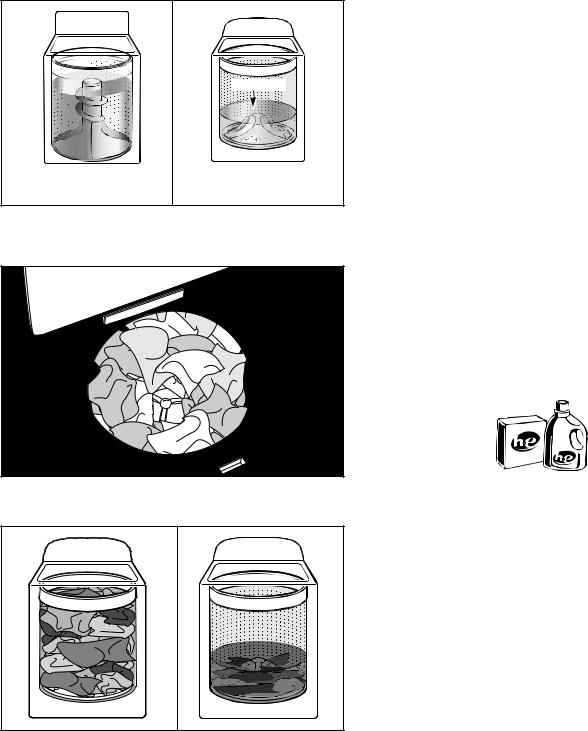
WHAT’S NEW UNDER THE LID?
Cleaning with Less Water
|
Washplate |
Traditional agitator-style |
Washer with low-water |
washer |
washplate wash system |
The most striking difference in your new washer is the low-water washplate wash system. The washer automatically adjusts the water level to the load size—no water level selector is needed.
For best performance, it is recommended to load items in loose heaps evenly around the washplate.
As the washer dampens and moves the load, the level of the items will settle in the basket. This is normal and does not indicate that more items should be added.
IMPORTANT: You will not see a washer basket full of water as with your past agitator-style washer. It is normal for some of the load to be above the water line.
Automatic Load Size Sensing
Once you start the cycle, the lid will lock and the washer will begin the sensing process to determine the correct water level for the load. This may take several minutes before water is added. You will find a step-by-step description in the “Cycle
Status Lights” section.
Initially the basket will start to spin prior to adding water; this is part of the sensing process and is normal. This low-water wash method uses less water and energy compared to a traditional agitator-style washer.
Choosing the Right Detergent
Use only High Efficiency detergents. The package will be marked “HE” or “High Efficiency.” Low-water washing creates excessive sudsing with a non-HE detergent. Using non-HE detergent
will likely result in longer cycle times and reduced rinsing performance. It may also result in component malfunction and, over time, buildup of mold or mildew. HE detergents should be low-sudsing and quick-dispersing to produce the right amount of suds for the best performance. They should hold soil in suspension so it is not redeposited onto clean clothes. Not all detergents labeled as High Efficiency are identical in formulation and their ability to reduce suds. For example, natural, organic, or homemade HE detergents may generate a high level of suds. If you use one of these and see an “F0E2” error code appear
in the display, consider using a different HE detergent. Always follow the detergent manufacturer’s instructions to determine the amount of detergent to use. Do not go over the Max line on the dispenser. See “Using Laundry Product Dispensers”
for more information.
Use only High Efficiency (HE) detergent.
Improved Cleaning
Low-water cleaning means concentrated cleaning. Rather than diluting detergent as done in an agitator-style washer, this washer delivers the detergent directly to the soils. This low
water wash also allows the clothing to move in a more effective way to remove soils.
Normal Sounds You Can Expect
At different stages of the wash cycle, you may hear sounds and noises that are different from those of your previous washer. For example, you may hear a clicking and hum at the beginning of the cycle as the lid lock goes through a self-test. There will be
different kinds of humming and whirring sounds as the washplate moves the load and as the basket is slowing down to stop. And sometimes, you may hear nothing at all as the washer determines the correct water level for your load or allows time for clothes
to soak.
3

CONTROL PANEL AND FEATURES
STEAM MODEL |
1 |
2 |
3 |
4 |
|
|
|
|
|
|
|
|
|
|
|
|
|
|
5 |
|
|
|
|
|
|
|
|
|
|
|
|
|
|
|
|
|
|
|
|
|
|
|
|
|
|
|
|
|
|
|
|
|
|
|
|
|
|
|
|
|
|
|
|
|
|
|
|
|
|
|
|
|
|
|
|
|
|
|
|
|
|
|
|
|
|
|
|
|
|
|
|
|
|
|
|
|
|
|
|
|
|
|
|
|
|
|
|
|
|
|
|
|
|
|
|
|
|
|
|
|
|
|
|
|
|
|
|
|
|
|
|
|
|
|
|
|
|
|
|
|
|
|
|
|
|
|
|
|
|
|
|
|
|
|
|
|
|
|
|
|
|
|
|
|
|
|
|
|
|
|
|
|
|
|
|
|
|
|
|
|
|
|
|
|
|
|
|
|
|
|
|
|
|
|
|
|
|
|
|
|
|
|
|
|
|
|
|
|
|
|
|
|
NON-STEAM MODEL |
|
|
|
|
|
|
|
6 |
|
7 |
|
8 |
|||||||||||||
|
|
|
|
|
|
|
|
4 |
|
|
|
|
|
|
|
|
|
||||||||
1 |
|
|
|
|
|
2 |
|
|
|
|
3 |
|
|
|
|
|
|
|
|
|
|||||
|
|
|
|
|
|
|
|
|
|
|
|
|
|
|
|
|
|
|
|
|
|
|
|
|
|
|
|
|
|
|
|
|
|
|
|
|
|
|
|
|
|
|
|
|
|
|
|
|
|
|
|
|
|
|
|
|
|
|
|
|
|
|
|
|
|
|
|
|
|
|
|
|
|
|
|
|
|
|
|
|
|
|
|
|
|
|
|
|
|
|
|
|
|
|
|
|
|
|
|
|
|
|
|
|
|
|
|
|
|
|
|
|
|
|
|
|
|
|
|
|
|
|
|
|
|
|
|
|
|
|
|
|
|
|
|
|
|
|
|
|
|
|
|
|
|
|
|
|
|
|
|
|
|
|
|
|
|
|
|
|
|
|
|
|
|
|
|
|
|
|
|
|
|
|
|
|
|
|
|
|
|
|
|
|
|
|
|
|
|
|
|
|
|
|
|
|
|
|
|
|
|
|
|
|
|
|
|
5 |
6 |
7 |
8 |
Not all features and cycles are available on all models.
NOTE: The control panel features a sensitive surface that responds to a light touch of your finger. To ensure your selections are registered, touch the control panel with your fingertip, not your fingernail. When selecting a setting or option, simply touch its name until the desired section is illuminated.
1POWER BUTTON
Touch to turn on the washer. Touch to stop/cancel a cycle at any time.
2WASH CYCLE KNOB
Turn the Wash Cycle knob to select a cycle for your laundry load. See “Cycle Guide” for detailed descriptions of cycles.
3TIME DISPLAY
The Estimated Time Remaining display shows the time required for the cycle to complete. Factors such as load size and water pressure may affect the time shown in the display. Overloading, unbalanced loads, or excessive suds may cause the washer to adjust the cycle time as well.
4DELAY WASH
Use “+” and “–” to delay the start of the wash cycle by up to 12 hours. To turn off Delay Wash, use “+” and “–” to set the delay time to “0,” or touch the Power button.
5START/PAUSE/UNLOCK LID BUTTON
Touch and hold the Start/Pause/Unlock Lid button for up to 3 seconds or until the washer starts the selected cycle; touch again to pause a cycle.
NOTE: If the washer is spinning, it may take several minutes to unlock the lid.
6CYCLE MODIFIERS
When you select a cycle, its default settings will light up.
WASH TEMP
Wash Temp control senses and maintains uniform water temperatures by regulating incoming hot and cold water.
Select a wash temperature based on the type of fabric and soils being washed. For best results and following the garment label instructions, use the warmest wash water safe for your fabric.
•On some models and cycles, warm and hot water may be cooler than what your previous washer provided.
•Even for cold wash settings, some warm water may be added to the washer to maintain a minimum temperature.
SOIL LEVEL
Select the most suitable setting for your load. For heavily soiled items, select Ex Heavy Soil Level for more wash time. For lightly soiled items, select Light Soil Level for less wash time.
Lighter soil level setting will help reduce tangling and wrinkling.
SPIN SPEED
This washer automatically selects the spin speed based on the cycle selected. The preset speeds can be changed. Not all spin speeds are available with all cycles.
•Faster spin speeds mean shorter dry times but may increase wrinkling in your load.
•Slower spin speeds mean less wrinkling but will leave your load more damp.
4

CYCLE SIGNAL
Use this option to adjust volume of the signal that sounds at end of cycle. The Cycle Signal is a helpful reminder to remove items from washer as soon as the cycle has completed.
To turn Button Sounds Either On or Off:
While washer is on, touch and hold the Cycle Signal button for 3 seconds. Washer will make a single beep when the process is complete.
NOTES:
•The Cycle Signal button will still operate, even if you turned the button sounds off.
•Whatever your preferences are, they remain in effect through a power loss.
•The Default setting for the button sounds is on.
7CYCLE OPTIONS
You may add or remove options for each cycle. Note that not all options can be used with all cycles, and some are preset to work with certain cycles.
PREWASH
Use this option to add an extra agitation and soak time to the beginning of any cycle to break up tough stains.
DEEP FILL
Will add the most amount of water for large or bulky loads. Items need to move freely. Tightly packing the load can lead to poor cleaning performance, and may increase wrinkling and tangling.
TWO RINSES
This option can be used to automatically add a second rinse to most cycles.
NOTE: If you want to drain and spin only, select the Rinse
& Spin cycle, then touch to turn off the Two Rinses option.
FABRIC SOFTENER
This option must be set to ON if using fabric softener. It ensures that fabric softener is added at the correct time in the rinse for even distribution.
STEAM TREAT for Steam models or STAIN BOOST for Non-Steam models
This option provides enhanced cleaning action for tough stains. It will add additional agitation and soak time to the cycle.
8CYCLE STATUS LIGHTS INDICATOR
The Cycle Status lights show the progress of a cycle. At each stage of the process you may notice sounds or pauses that are different from traditional washers.
DELAY
When Delay Wash is selected, this light will come on to indicate your washer is set up to run a delayed wash.
ADD A GARMENT
You may place additional clothing in the wash when the
Add a Garment indicator is lit without sacrificing wash performance. Touch the Start/Pause/Unlock Lid button once. The Lid Locked light will turn off. Open the washer lid, add garments, and close the lid. Touch and hold the Start/Pause/Unlock Lid button to restart.
WASH
You will hear the motor and washplate moving the load. It is normal for some of the load to be above the water line. Low-water cleaning means concentrated cleaning.
Rather than diluting detergent as done in an agitator-style washer, this washer delivers the detergent directly to the soils. The motor sounds may change at different stages in the cycle. The wash time is determined by the selected Soil Level.
RINSE
You will hear sounds similar to the wash cycle as the washer rinses and moves the load. Fabric softener will be added if the Fabric Softener option was selected.
SPIN
The washer spins the load at increasing speeds for proper water removal based on the selected cycle and spin speed.
COMPLETE
Once the cycle is complete, this light will come on. Remove the load promptly for best results.
LID LOCKED
To allow for proper load sensing and spinning, the lid will lock and the Lid Locked light will turn on. This light indicates that the lid is locked and cannot be opened.
If you need to open the lid, touch the Start/Pause/Unlock Lid button. The lid will unlock once the washer movement has stopped. This may take several minutes if the load was spinning at high speed. Touch and hold the Start/Pause/ Unlock Lid button again for up to 3 seconds to resume
the cycle.
5
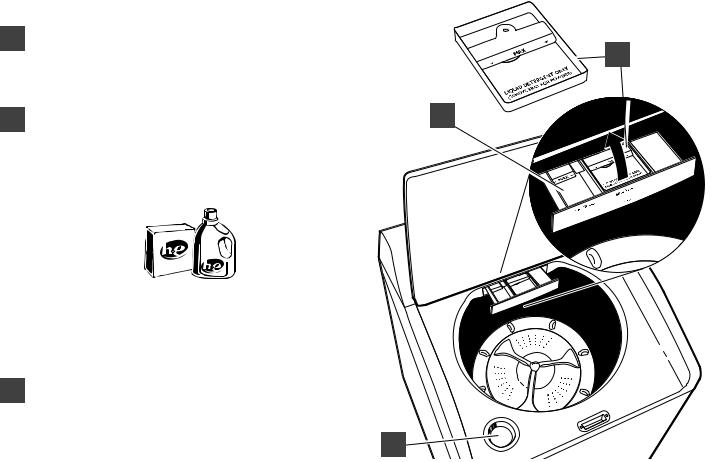
Dispensers
A |
Liquid fabric softener dispenser |
|
|
Pour measured liquid fabric softener into the liquid fabric |
B |
||
|
|||
|
softener dispenser, if desired. It will dispense automatically |
|
at the optimum time.
• Use only liquid fabric softener in this dispenser.
B
High Efficiency “HE” detergent dispenser A
Add liquid or powdered HE detergent product to this dispenser for your main wash cycle. Remove tray if using powder detergent.
IMPORTANT: Make sure tray is in drawer when using
liquid detergent and removed when using powder detergent.
Do not go over the Max line.
Use only High Efficiency (HE) detergent.
NOTE: Follow the manufacturer’s instructions to determine the amount of detergent to use. Do not add single-dose laundry packets, color-safe bleach, or fabric softener crystals to dispensers. They will not dispense correctly.
C |
Liquid chlorine bleach dispenser |
|
This dispenser holds up to ¾ cup (180 mL) liquid chlorine |
|
|
|
bleach. The bleach will be automatically diluted and |
|
|
dispensed at the optimum time during the wash cycle. |
|
|
This dispenser cannot dilute powdered bleach. |
C |
|
NOTE: Fill dispenser with only liquid bleach. |
|
6
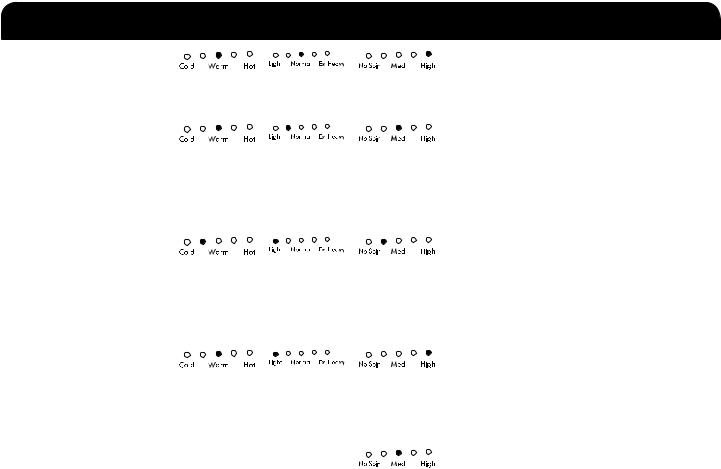
CYCLE GUIDE
Settings shown are default settings for that cycle. Once you select a cycle, the default modifiers or the previous set modifiers for that cycle will be lit. For best fabric care, choose the cycle that best fits the load being washed. Not all cycles and options are available on all models.
Items to Wash: |
Cycle: |
|
|
Wash |
Soil |
Spin |
Available |
Cycle Details: |
||
|
|
|
|
Temp:* |
Level: |
Speed: |
Options: |
|
||
|
|
|
|
|
|
|
|
|
|
|
Cottons, linens, |
Normal |
|
|
|
|
|
|
|
Prewash |
Use this cycle to clean normally |
and mixed item |
|
|
|
|
|
|
|
|
Two Rinses |
soiled cottons and mixed fabric |
loads |
|
|
|
|
|
|
|
|
Fabric Softener |
loads. Default settings can be |
|
|
|
|
|
|
|
|
|
Steam Treat or |
adjusted as needed. |
|
|
|
|
|
|
|
|
|
Stain Boost |
|
No-iron |
Casual |
|
|
|
|
|
|
|
Prewash |
Use this cycle for no-iron |
fabrics, cottons, |
|
|
|
|
|
|
|
|
Two Rinses |
fabrics such as sport shirts, |
permanent |
|
|
|
|
|
|
|
|
Fabric Softener |
blouses, casual business clothes, |
press, linens, |
|
|
|
|
|
|
|
|
Steam Treat or |
permanent press, and blends. |
synthetics |
|
|
|
|
|
|
|
|
Stain Boost |
The cycle uses a warm wash, |
|
|
|
|
|
|
|
|
|
|
a cooldown, and medium |
|
|
|
|
|
|
|
|
|
|
spin speeds for better wrinkle |
|
|
|
|
|
|
|
|
|
|
performance. |
Machine-wash |
Delicates |
|
|
|
|
|
|
|
Prewash |
Use this cycle for machine- |
silks, hand-wash |
|
|
|
|
|
|
|
|
Two Rinses |
washable delicate items. This |
fabrics, and |
|
|
|
|
|
|
|
|
Fabric Softener |
cycle uses intermittent wash |
wool |
|
|
|
|
|
|
|
|
Steam Treat or |
action with cool water and |
|
|
|
|
|
|
|
|
|
Stain Boost |
slow spin to gently care for fine |
|
|
|
|
|
|
|
|
|
|
washables and avoid shrinkage. |
|
|
|
|
|
|
|
|
|
|
Place small items in mesh bags |
|
|
|
|
|
|
|
|
|
|
before washing. |
Lightly soiled |
Express |
|
|
|
|
|
|
|
Prewash |
Use this cycle to wash a few |
items |
|
|
|
|
|
|
|
|
Two Rinses |
lightly soiled items that are |
|
|
|
|
|
|
|
|
|
Fabric Softener |
needed in a hurry. This short |
|
|
|
|
|
|
|
|
|
Steam Treat or |
cycle combines high-speed |
|
|
|
|
|
|
|
|
|
Stain Boost |
wash action and high-speed |
|
|
|
|
|
|
|
|
|
|
spin for best cleaning and |
|
|
|
|
|
|
|
|
|
|
shortened dry time. |
Swimsuits, |
Rinse & |
|
|
N/A |
N/A |
|
Two Rinses |
Combines a rinse and high |
||
items that need |
Spin |
|
|
|
|
|
|
|
|
spin speed for loads requiring |
rinsing only |
|
|
|
|
|
|
|
|
|
an additional rinse cycle or to |
|
|
|
|
|
|
|
|
|
|
complete a load after power |
|
|
|
|
|
|
|
|
|
|
interruption. Also use for loads |
|
|
|
|
|
|
|
|
|
|
that require rinsing only. If you |
|
|
|
|
|
|
|
|
|
|
want to drain and spin only, |
|
|
|
|
|
|
|
|
|
|
select the Rinse & Spin cycle; |
|
|
|
|
|
|
|
|
|
|
then touch to turn off the Two |
|
|
|
|
|
|
|
|
|
|
Rinses option. Use Drain & Spin |
|
|
|
|
|
|
|
|
|
|
to spin excess water out of a |
|
|
|
|
|
|
|
|
|
|
load. |
No clothes |
Clean |
|
|
N/A |
N/A |
N/A |
N/A |
Use this cycle every 30 washes |
||
in washer |
Washer |
|
|
|
|
|
|
|
|
to keep the inside of your washer |
|
|
|
|
|
|
|
|
|
|
fresh and clean. This cycle uses a |
|
|
|
|
|
|
|
|
|
|
higher water level. Use with liquid |
|
|
|
|
|
|
|
|
|
|
chlorine bleach to thoroughly |
|
|
|
|
|
|
|
|
|
|
clean the inside of your washer. |
|
|
|
|
|
|
|
|
|
|
This cycle should not be |
|
|
|
|
|
|
|
|
|
|
interrupted. See “Washer Care.” |
|
|
|
|
|
|
|
|
|
|
IMPORTANT: Do not place |
|
|
|
|
|
|
|
|
|
|
garments or other items in the |
|
|
|
|
|
|
|
|
|
|
washer during the Clean Washer |
|
|
|
|
|
|
|
|
|
|
cycle. Use this cycle with an |
|
|
|
|
|
|
|
|
|
|
empty wash tub. |
*Wash temperatures vary according to the chosen cycle setting. All rinses are cold.
7
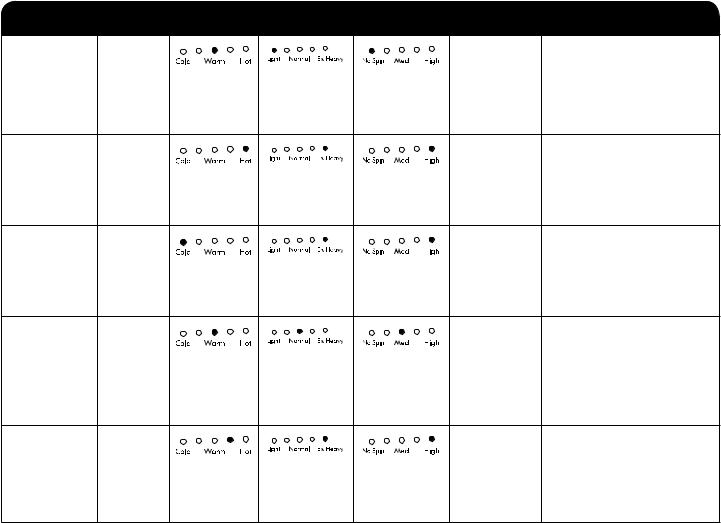
CYCLE GUIDE
Settings shown are default settings for that cycle. Once you select a cycle, the default modifiers or the previous set modifiers for that cycle will be lit. For best fabric care, choose the cycle that best fits the load being washed. Not all cycles and options are available on all models.
Items to Wash: |
Cycle: |
Wash |
Soil |
Spin |
Available |
Cycle Details: |
|
|
Temp:* |
Level: |
Speed: |
Options: |
|
Heavily soiled |
Soak |
|
|
|
Prewash |
Use this cycle to soak small |
fabrics |
|
|
|
|
Two Rinses |
spots of set-in stains on fabrics. |
|
|
|
|
|
Fabric Softener |
The washer will use intermittent |
|
|
|
|
|
Steam Treat or |
agitation and soaking. After |
|
|
|
|
|
Stain Boost |
time has expired, water will |
|
|
|
|
|
|
drain, but the washer will not |
|
|
|
|
|
|
spin. Cycle is complete. |
Heavily soiled |
Whites |
|
|
|
Prewash |
This cycle adds liquid chlorine |
white fabrics |
|
|
|
|
Deep Fill |
bleach to the load at the |
|
|
|
|
|
Two Rinses |
proper time for improved |
|
|
|
|
|
Fabric Softener |
whitening of soiled white |
|
|
|
|
|
Steam Treat or |
fabrics. |
|
|
|
|
|
Stain Boost |
|
Bright or darkly |
Cold Clean |
|
|
|
Prewash |
Cold water with an additional |
colored cottons, |
|
|
|
|
Deep Fill |
wash action gently lifts stains |
linens, casual |
|
|
|
|
Two Rinses |
while caring for fabrics. |
and mixed |
|
|
|
|
Fabric Softener |
Settings may be adjusted as |
loads |
|
|
|
|
Steam Treat or |
desired but must use only cold |
|
|
|
|
|
Stain Boost |
water settings. |
Large items |
Bulky/ |
|
|
|
Prewash |
Use this cycle to wash large |
such as sheets, |
Bedding |
|
|
|
Deep Fill |
items such as jackets and small |
sleeping |
|
|
|
|
Two Rinses |
comforters. The washer will |
bags, small |
|
|
|
|
Fabric Softener |
fill with enough water to wet |
comforters, |
|
|
|
|
Steam Treat or |
down the load before the wash |
jackets, small |
|
|
|
|
Stain Boost |
portion of the cycle begins and |
washable rugs |
|
|
|
|
|
uses a higher water level than |
|
|
|
|
|
|
other cycles. |
Sturdy fabrics, |
Heavy |
|
|
|
Prewash |
Use this cycle for heavily soiled |
colorfast items |
Duty |
|
|
|
Deep Fill |
or sturdy cotton items. This |
|
|
|
|
|
Two Rinses |
cycle combines high-speed |
|
|
|
|
|
Fabric Softener |
wash action, longer wash time, |
|
|
|
|
|
Steam Treat or |
and extra high-speed spin to |
|
|
|
|
|
Stain Boost |
shorten drying times. Adjust |
|
|
|
|
|
|
temperature settings as needed. |
*Wash temperatures vary according to the chosen cycle setting. All rinses are cold.
8
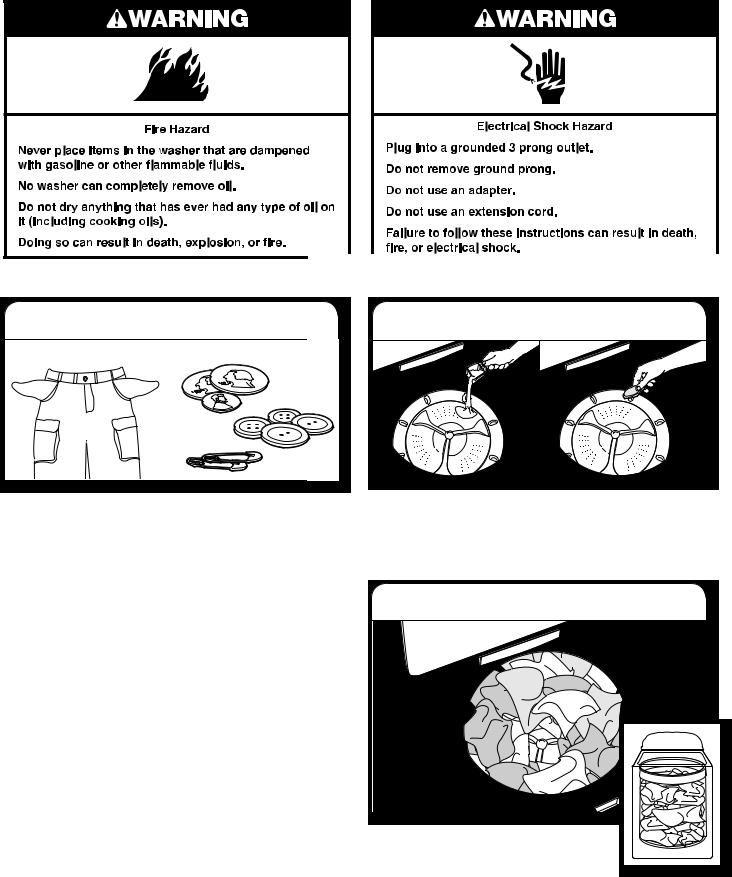
USING YOUR WASHER
1. Sort and prepare your laundry
2. Add laundry products if desired
•Empty pockets. Loose change, buttons, or any small object can pass under the washplate and become trapped, causing unexpected sounds.
•Sort items by recommended cycle, water temperature, and colorfastness.
•Separate heavily soiled items from lightly soiled.
•Separate delicate items from sturdy fabrics.
•Do not dry items if stains remain after washing; heat can set stains into fabric.
•Treat stains promptly.
•Close zippers, fasten hooks, tie strings and sashes. Remove non-washable trim and ornaments.
•Mend rips and tears to avoid further damage to items during washing.
Helpful Tips:
•For best performance, use HE liquid detergent when washing bulky items.
•When washing waterproof or water-resistant items, load evenly. See “Cycle Guide” for tips and more information on using the Bulky/Bedding cycle.
•Use mesh bags to help prevent tangling when washing delicate or small items.
•Turn knits inside out to avoid pilling. Separate lint-takers from lint-givers. Synthetics, knits, and corduroy fabrics will pick up lint from towels, rugs, and chenille fabrics.
NOTE: Always read and follow fabric care label instructions to avoid damage to your items.
Single-dose laundry packet, color-safe bleach, or fabric softener crystals can be added to the basket prior to adding laundry.
NOTE: Do not add clothes to washer basket prior to adding laundry products. Always follow manufacturer’s instructions.
3. Load laundry into washer
For best performance, load items in loose heaps evenly around the washplate.
Try mixing different-sized items to reduce tangling.
IMPORTANT: Items need to move freely
for best cleaning and to reduce wrinkling and tangling.
9

Using Laundry Product Dispensers
NOTE: Do not add single-dose laundry packets, color-safe bleach, or fabric softener crystals to dispensers. They will not dispense correctly.
4. Add HE detergent
Removable HE |
detergent tray |
Add a measured amount of HE liquid detergent into detergent tray. This tray holds
3 oz. (89 mL). If adding powder HE detergent, remove inside tray. Do not overfill tray – adding too much detergent may cause detergent to be dispensed into the washer too early.
NOTE: Make sure tray is in drawer when using liquid detergent and removed when using powder detergent. Do not go over the
Max line.
IMPORTANT: Use only High Efficiency detergents. The package will be marked “HE” or “High Efficiency.” Low-water washing creates excessive sudsing with a non-HE detergent. Using non-HE detergent will likely result in longer cycle times and reduced rinsing performance. It may also result in component malfunction and, over time, buildup of mold or mildew. HE detergents should be low-sudsing and quick-dispersing to produce the right amount of suds for the best performance. They should hold soil in suspension so it is not redeposited onto clean clothes. Not all detergents labeled as High Efficiency are identical in formulation and their ability to reduce suds.
For example, natural, organic, or homemade HE detergents may generate a high level of suds. If you use one of these and see an “F0E2” error code appear in the display, consider using a different HE detergent. Always follow the detergent manufacturer’s instructions to determine the amount of detergent to use.
HELPFUL TIP: See “Washer Maintenance” for information on the recommended method of cleaning washer dispenser trays.
5. Add liquid chlorine bleach to dispenser
Liquid
Chlorine Bleach
Do not overfill, dilute, or use more than 1 cup (236 mL). Do not use color-safe bleach or Oxi products in the same cycle with liquid chlorine bleach.
6. Add liquid fabric softener
Fabric softener tray
Pour a measured amount of liquid fabric softener into tray; always follow manufacturer’s directions for correct amount of fabric softener based on your load size. Close dispenser drawer. Fabric
softener is added during rinse.
IMPORTANT: Do not overfill or dilute. Overfilling dispenser will cause fabric softener to immediately dispense into washer.
If Two Rinses option is selected, fabric softener will be dispensed into the last rinse.
It is normal for a small amount of water to remain in the dispenser at the end of a cycle.
7. Touch Power button to turn on washer
Make sure the dispenser drawer is closed completely, then touch the Power button to turn on the washer. Other methods of turning on the washer include opening the lid or turning the Wash Cycle knob.
10
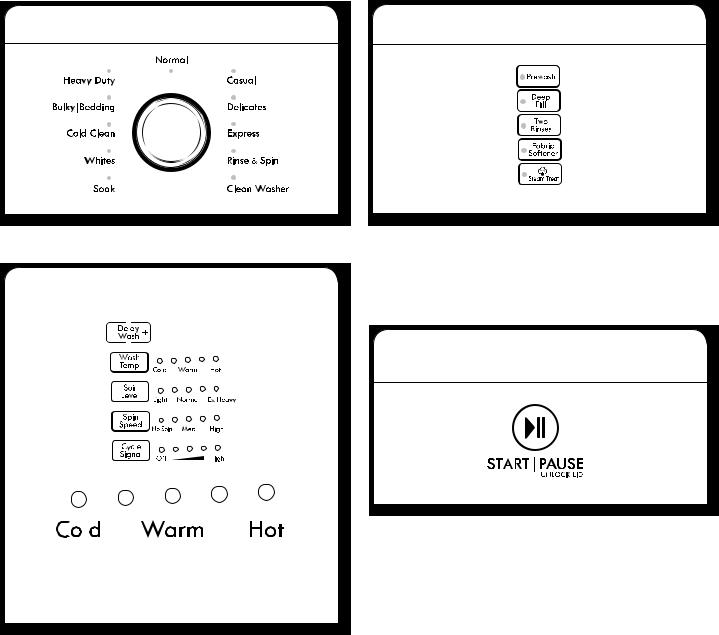
8. Select cycle |
10. Select cycle options |
Turn cycle knob to choose your wash cycle.
9. Select cycle modifiers, if desired
|
|
|
|
|
|
|
|
|
|
|
|
|
|
|
|
|
|
|
|
|
|
|
|
|
|
|
|
|
|
|
|
|
|
|
|
|
|
|
|
|
|
|
|
|
|
|
|
|
|
|
|
|
|
|
|
|
|
|
|
|
|
|
|
|
|
|
|
|
|
|
|
|
|
|
|
|
|
|
|
|
|
|
|
|
|
|
|
|
|
|
|
|
|
|
|
|
|
|
|
|
|
|
|
|
|
|
|
|
|
|
|
|
|
|
|
|
|
|
|
|
|
|
|
|
|
|
|
|
|
|
|
|
|
|
|
|
|
|
|
|
|
|
|
|
|
|
|
|
|
|
|
|
|
|
|
|
|
|
|
|
|
|
|
|
|
|
|
|
|
|
|
|
|
|
|
|
|
|
|
|
|
|
|
|
|
|
|
|
|
|
|
|
|
|
|
|
|
|
|
|
|
|
|
|
|
|
|
|
|
|
|
|
|
|
|
|
|
|
|
|
|
|
|
|
|
|
|
|
|
|
|
|
|
|
|
|
|
|
|
|
|
|
|
|
|
|
|
|
|
|
|
|
|
|
|
|
|
|
|
|
|
|
|
|
|
|
|
|
|
Light soils |
|
Moderate soils |
Heavy Soils |
|||||||||||
Colors that bleed |
|
|
Bright colors |
Whites |
||||||||||
or fade |
|
|
|
|
|
|
|
Pastels |
||||||
|
|
|
|
|
|
|
|
|
|
|
|
|
||
|
|
|
|
|
|
|
|
|
|
|
|
|
|
|
Once you select a cycle, the default settings for that cycle
will be lit. Touch the cycle modifier buttons to change the Wash
Temp, Soil Level, and Spin Speed, if desired. Not all settings are available with all cycles. Even for cold wash settings, some warm water may be added to the washer to maintain a minimum temperature.
NOTE: Always read and follow fabric care label instructions to avoid damage to your items. If not sure which temperature to use, refer to the diagram above or select a cooler temperature.
Steam model shown
Select any other cycle options you may wish to add if not previously set. Some cycles will automatically add certain options such as Two Rinses. These may be turned off,
if desired.
NOTE: Not all options are available with all cycles.
11. Touch and hold Start/Pause/Unlock Lid button to begin wash cycle
Touch and hold the Start/Pause/Unlock Lid button for up to
3 seconds to start the wash cycle. When the cycle has finished, the Complete indicator will light and the end-of-cycle signal will sound (if set). Promptly remove items when cycle is done to avoid odor, reduce wrinkling, and avoid rusting of metal hooks, zippers, and snaps.
Unlocking the lid to add garments
If you need to open the lid to add 1 or 2 missed items:
Touch the Start/Pause/Unlock Lid button to pause the washer; the lid will unlock once the washer movement has stopped. This may take several minutes if the load was spinning at high speed. Then close the lid and touch and hold the Start/Pause/ Unlock Lid button again for up to 3 seconds to restart the cycle.
IMPORTANT: If the lid is left open for more than 10 minutes, the water will pump out and the F8E6 error code will appear on the display.
11

WASHER MAINTENANCE
WATER INLET HOSES
Replace inlet hoses after 5 years of use to reduce the risk of hose failure. Periodically inspect and replace inlet hoses if bulges, kinks, cuts, wear, or leaks are found.
When replacing your inlet hoses, mark the date of replacement on the label with a permanent marker.
NOTE: This washer does not include inlet hoses. See the Installation Instructions for more information.
WASHER CARE
Recommendations to Help Keep Your Washer Clean and Performing at Its Best
1.Always use High Efficiency (HE) detergents and follow the HE detergent manufacturer’s instructions regarding the amount of HE detergent to use. Never use more than the recommended amount because that may increase the rate at which detergent and soil residue accumulate inside your washer, which in turn may result in undesirable odor.
2.Use warm and hot wash water settings sometimes (not exclusively cold water washes), because they do a better job of controlling the rate at which soils and detergent accumulate.
3.Always leave the washer lid open between uses to help
dry out the washer and prevent the buildup of odor-causing residue.
Cleaning Your Top-Loading Washer
Read these instructions completely before beginning the routine cleaning processes recommended below. This Washer Maintenance Procedure should be performed, at a minimum, once per month or every 30 wash cycles, whichever occurs sooner, to control the rate at which soils and detergent may otherwise accumulate in your washer.
Cleaning the Inside of the Washer
To keep your washer odor free, follow the usage instructions provided above and use this recommended monthly cleaning procedure:
Clean Washer Cycle
This washer has a special cycle that uses higher water volumes in combination with liquid chlorine bleach to clean the inside of the washer.
Begin procedure
Chlorine Bleach Procedure:
a.Open the washer lid and remove any clothing or items.
b.Add 1 cup (236 mL) of liquid chlorine bleach to the bleach compartment.
NOTE: Use of more liquid chlorine bleach than is recommended above could cause washer damage over time.
c.Close the washer lid.
d.Do not add any detergent or other chemical to the washer when following this procedure.
e.Select the Clean Washer cycle.
f.Touch and hold the Start/Pause/Unlock button
to begin the cycle. The Clean Washer Cycle Operation is described below.
NOTE: For best results, do not interrupt the cycle. If the cycle must be interrupted, touch the Power button. (For models with no Power button, touch and hold the Start/ Pause/Unlock button for three seconds). After the Clean
Washer cycle has stopped, run a Rinse & Spin cycle to rinse cleaner from washer.
WASHER CARE (cont.)
Description of Clean Washer Cycle Operation:
1.This cycle will fill to a water level higher than in normal wash cycles to provide rinsing at a level above the water line for normal wash cycle.
2.During this cycle, there will be some agitation and spinning to increase the removal of soils.
After this cycle is complete, leave the lid open to allow for better ventilation and drying of the washer interior.
Cleaning the Dispensers
After a period of using your washer, you may find some residue buildup in the washer’s dispensers. To remove residue from the dispensers, wipe them with a damp cloth and towel dry. Do not attempt to remove the dispensers or trim for cleaning. The dispensers and trim are not removable. If your model has a dispenser drawer, however, remove the drawer and clean it before or after you run the Clean Washer cycle. Use an all-purpose surface cleaner, if needed.
Cleaning the Outside of the Washer
Use a soft, damp cloth or sponge to wipe away any spills.
Use only mild soaps or cleaners when cleaning external washer surfaces.
IMPORTANT: To avoid damaging the washer’s finish, do not use abrasive products.
NON-USE AND VACATION CARE
Operate your washer only when you are home. If moving, or not using your washer for a period of time, follow these steps:
1.Unplug or disconnect power to washer.
2.Turn off water supply to washer to avoid flooding due to water pressure surge.
12
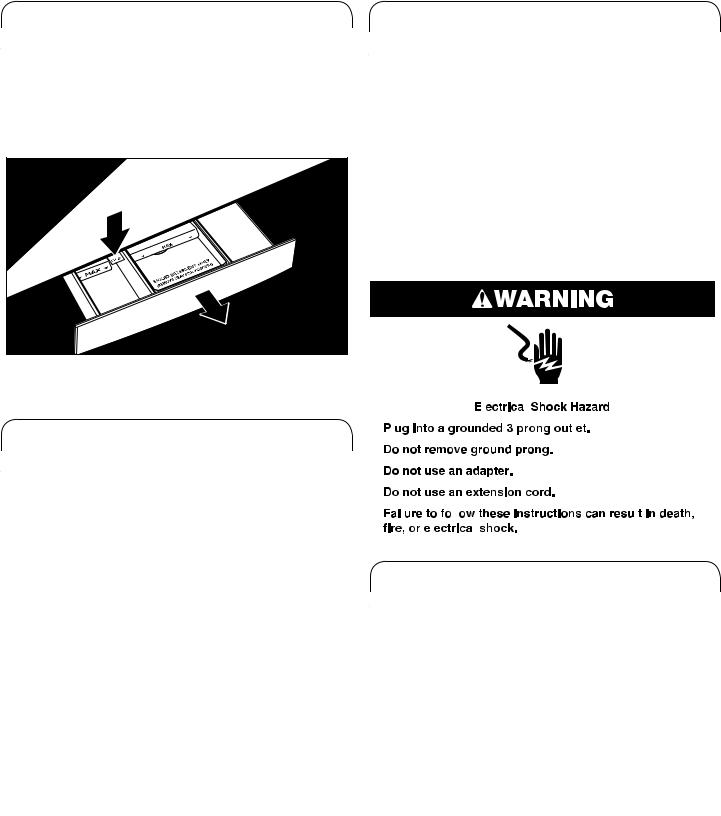
CLEANING YOUR DISPENSER
You may find laundry product residue left over in your dispenser drawer. To remove residue, follow this recommended cleaning procedure:
1.Pull drawer out until you feel resistance.
2.Push 1 tab downward, then continue pulling out.
3.Wash in warm, soapy water, using a mild detergent.
4.Rinse with warm water.
5.Air dry or dry with a towel, then place back into slot.
IMPORTANT: Dispenser drawer and tray are not dishwasher safe.
WINTER STORAGE CARE
IMPORTANT: To avoid damage, install and store washer where it will not freeze. Because some water may stay in hoses, freezing can damage washer. If storing or moving during freezing weather, winterize your washer.
To winterize washer:
1.Shut off both water faucets. Disconnect and drain water inlet hoses.
2.Put 1 qt. (1 L) of R.V.-type antifreeze in basket and run washer on Rinse & Spin cycle for about 30 seconds to mix antifreeze and remaining water.
3.Unplug washer or disconnect power.
TRANSPORTING YOUR WASHER
1.Shut off both water faucets. Disconnect and drain water inlet hoses.
2.If washer will be moved during freezing weather, follow “Winter Storage Care” directions before moving.
3.Disconnect drain hose from drain system.
4.Unplug power cord.
5.Place inlet hoses inside washer basket.
6.Drape power cord and drain hose over the console and secure with masking tape.
7.Place foam packing ring from original shipping materials back inside washer. If you do not have packing ring, place heavy blankets or towels into basket opening. Close lid and place tape over lid and down front of washer. Keep lid taped until washer is placed in new location. Transport washer in upright position.
REINSTALLING/USING WASHER AGAIN
To reinstall washer after non-use, vacation, winter storage, or moving:
1.Refer to Installation Instructions to locate, level, and connect washer.
2.Before using again, run washer through the following recommended procedure:
To use washer again:
1.Flush water pipes and hoses. Reconnect water inlet hoses. Turn on both water faucets.
2.Plug in washer or reconnect power.
3.Run washer through Bulky/Bedding cycle to clean washer and remove antifreeze, if used. Use only HE High Efficiency detergent. Use half the manufacturer’s recommended amount for a medium-size load.
13

TROUBLESHOOTING
First try the solutions suggested here for assistance and to possibly avoid a service call.
If you experience |
Possible Causes |
Solution |
Vibration or Off-Balance
Vibration, rocking, “walking,” or washer stopped with all dial lights flashing
Feet may not be in contact with the |
Front and rear feet must be in firm contact with floor, and washer |
floor and locked. |
must be level to operate properly. Jam nuts must be tight against |
|
the bottom of the cabinet. |
Washer may not be level. |
Check floor for flexing or sagging. If flooring is uneven, a ¾" |
|
(19 mm) piece of plywood under your washer will reduce sound. |
|
See “Level the Washer” in the Installation Instructions. |
|
|
Load could be unbalanced. |
Load items in loose heaps evenly around the washplate. Adding |
|
wet items to washer or adding more water to basket could |
|
unbalance washer. |
|
Avoid washing single items. Balance a single item, such as a rug |
|
or jeans jacket, with a few extra items. If the dial is flashing, |
|
redistribute the load, close the lid, and touch and hold the Start/ |
|
Pause/Unlock Lid button. |
|
Use Bulky/Bedding cycle for oversized, non-absorbent items such |
|
as comforters or poly-filled jackets. Other items may not be |
|
appropriate for Bulky/Bedding cycle. See “Cycle Guide.” |
|
Item or load not suitable for selected cycle. See “Cycle Guide” |
|
and “Using Your Washer.” |
|
|
Noises
Clicking or metallic noises |
Objects caught in washer drain |
Empty pockets before washing. Loose items, such as coins, could |
|
system. |
fall between basket and tub or may block pump. It may be |
|
|
necessary to call for service to remove items. |
|
|
It is normal to hear metal items on clothing, such as metal snaps, |
|
|
buckles, or zippers, touch against the stainless steel basket. |
Gurgling or humming |
Washer may be draining water. |
It is normal to hear the pump making a continuous humming |
|
|
sound with periodic gurgling or surging as final amounts of water |
|
|
are removed during the spin/drain cycles. |
Humming |
Load sensing may be occurring. |
You may hear the hum of the sensing spins after you have started |
|
|
the washer. This is normal. |
Whirring |
Basket may be slowing down. |
You may hear the whirring sound of the basket decelerating. |
|
|
This is normal. |
Water Leaks |
|
|
Check the following for proper installation:
Washer not level. |
Water may splash off basket if washer is not level. |
Fill hoses not attached tightly. |
Tighten fill-hose connection. |
|
|
Fill hose washers |
Make sure all four fill hose flat washers are properly seated. |
Drain hose connection |
Pull drain hose from washer cabinet and properly secure it to |
|
drainpipe or laundry tub. |
|
Do not place tape over drain opening. |
Check household plumbing for leaks |
Water can back up out of a clogged sink or drainpipe. Check |
or clogged sink or drain. |
all household plumbing for leaks (laundry tubs, drain pipe, water |
|
pipes, and faucets.) |
Washer not loaded as recommended. |
An unbalanced load can cause basket to be out of alignment |
|
and cause water to splash off tub. See “Using Your Washer” for |
|
loading instructions. |
|
|
Washer not performing as expected
Not enough water |
Load not completely covered in water. |
This is normal operation for an HE low-water washer. The load will |
in washer |
|
not be completely underwater. The washer senses load sizes and |
|
|
adds correct amount of water for optimal cleaning. See “What’s |
|
|
New under the Lid.” |
|
|
IMPORTANT: Do not add more water to washer. Adding water |
|
|
lifts the items off the washplate, resulting in less effective cleaning. |
|
|
Run Clean Washer cycle to optimize the water level and wash |
|
|
performance. |
14

TROUBLESHOOTING
First try the solutions suggested here for assistance and to possibly avoid a service call.
If you experience |
Possible Causes |
Solution |
Washer not performing as expected (cont.)
Washer won’t run or fill, Check for proper water supply. washer stops working
Both hoses must be attached and have water flowing to inlet valve.
Both hot and cold water faucets must be turned on.
Check that inlet valve screens have not become clogged.
Check for any kinks in inlet hoses, which can restrict water flow.
|
|
|
|
|
|
|
|
|
|
|
|
|
|
|
|
|
|
|
|
|
|
|
|
|
|
|
|
|
|
|
|
|
|
|
|
|
|
|
|
|
|
|
|
|
|
|
|
|
|
|
|
|
|
|
|
|
|
|
|
|
|
|
|
|
|
|
|
|
|
|
|
|
|
|
|
|
|
|
|
|
|
|
|
|
|
|
|
|
|
|
|
|
|
|
|
|
|
|
|
|
|
|
|
|
|
|
|
|
|
|
|
|
|
|
|
|
|
|
|
|
|
|
|
|
|
|
|
|
|
|
|
|
|
|
|
|
|
|
|
|
|
|
|
|
|
|
|
|
|
|
|
|
|
|
|
|
|
|
|
|
|
|
|
|
|
|
|
|
|
|
|
|
|
|
|
|
|
|
|
|
|
|
|
|
|
|
|
|
|
|
|
|
|
|
|
|
|
|
|
|
|
|
|
|
|
|
|
|
|
If you experience |
|
|
|
Possible Causes |
|
Solution |
||||||||
Washer not performing as expected (cont.) |
|
|
||||||||||||
Washer won’t run or fill; |
Check proper electrical supply. |
|
Plug power cord into a grounded 3 prong outlet. |
|||||||||||
washer stops working |
|
|
|
|
|
|
|
|||||||
|
|
|
|
|
|
Do not use an extension cord. |
||||||||
(cont.) |
|
|
|
|
|
|
||||||||
|
|
|
|
|
|
|
||||||||
|
|
|
|
|
|
|
|
|
|
|
|
|
|
Ensure there is power to outlet. |
|
|
|
|
|
|
|
|
|
|
|
|
|
|
Reset a tripped circuit breaker. Replace any blown fuses. |
|
|
|
|
|
|
|
|
|
|
|
|
|
|
NOTE: If problems continue, contact an electrician. |
|
|
|
|
|
|
|
|
|
|
|
||||
|
|
|
|
|
|
|
|
Normal washer operation. |
|
Lid must be closed for washer to run. |
||||
|
|
|
|
|
|
|
|
|
|
|
|
|
|
Washer will pause during certain phases of cycle. Do not interrupt |
|
|
|
|
|
|
|
|
|
|
|
|
|
|
cycle. |
|
|
|
|
|
|
|
|
|
|
|
|
|
|
Washer may be stopped to reduce suds. |
|
|
|
|
|
|
|
|
|
|
|
||||
|
|
|
|
|
|
|
|
Washer may be tightly packed. |
|
Remove several items, rearrange load evenly around the washplate. |
||||
|
|
|
|
|
|
|
|
|
|
|
|
|
|
Close lid and touch and hold the Start/Pause/Unlock Lid button. |
|
|
|
|
|
|
|
|
|
|
|
|
|
|
Add only 1 or 2 additional items after washer has started. |
|
|
|
|
|
|
|
|
|
|
|
|
|
|
|
|
|
|
|
|
|
|
|
|
|
|
|
|
|
Do not add more water to the washer. |
|
|
|
|
|
|
|
|
Not using HE detergent or using too |
|
Only use HE detergent. Suds from regular detergents can slow or |
||||
|
|
|
|
|
|
|
|
much HE detergent. |
|
stop the washer. Always measure detergent and follow detergent |
||||
|
|
|
|
|
|
|
|
|
|
|
|
|
|
directions based on your load requirements. |
|
|
|
|
|
|
|
|
|
|
|
|
|
|
To remove suds, cancel cycle. Select RINSE & SPIN. Select your cycle. |
|
|
|
|
|
|
|
|
|
|
|
|
|
|
Touch and hold the Start/Pause/Unlock Lid button. Do not add more |
|
|
|
|
|
|
|
|
|
|
|
|
|
|
detergent. |
Washer not draining/ |
Small items may have been caught |
|
Empty pockets and use garment bags for small items. |
|||||||||||
spinning, loads are |
in pump or between basket and tub, |
|
|
|||||||||||
still wet |
which can slow draining. |
|
|
|||||||||||
|
|
|
|
|
|
|
|
Using cycles with a lower spin speed. |
|
Cycles with lower spin speeds remove less water than cycles |
||||
|
|
|
|
|
|
|
|
|
|
|
|
|
|
with high spin speeds. Use the recommended cycle/spin speed |
|
|
|
|
|
|
|
|
|
|
|
|
|
|
for your item. |
15

TROUBLESHOOTING
First try the solutions suggested here for assistance and to possibly avoid a service call.
If you experience |
Possible Causes |
Solution |
|
|
|
Washer not performing as expected (cont.) |
|
|
Washer not draining/ |
Washer may be tightly packed |
Tightly packed loads may not allow the washer to spin correctly, |
spinning, loads are still |
or unbalanced. |
leaving the load wetter than normal. Evenly arrange the wet load |
wet (cont.) |
|
for balanced spinning. Select DRAIN & SPIN to remove excess |
|
|
water. See “Using Your Washer” for loading recommendations. |
|
Load off balance. |
See “Vibration or Off-Balance” in “Troubleshooting” section for |
|
|
more information. |
|
Check plumbing for correct |
Check drain hose for proper installation. Use drain hose form |
|
drain hose installation. Drain hose |
and securely attach to drainpipe or tub. Do not tape over drain |
|
extends into standpipe farther than |
opening. Lower drain hose if the end is higher than 96" (2.4 m) |
|
4.5" (114 mm). |
above the floor. Remove any clogs from drain hose. |
|
Not using HE detergent or using too |
Suds from regular detergent or using too much detergent can |
|
much HE detergent. |
slow or stop draining or spinning. Use only HE detergent. Always |
|
|
measure and follow detergent directions for your load. To remove |
|
|
extra suds, select RINSE & SPIN. Do not add detergent. |
Dry spots on load after |
High spin speeds extract more |
The high spin speeds combined with airflow during the final spin |
cycle |
moisture than traditional top-load |
can cause items near the top of the load to develop dry spots |
|
washers. |
during the final spin. This is normal. |
Incorrect or wrong wash |
Check for proper water supply. |
Make sure hot and cold inlet hoses are not reversed. |
or rinse temperatures |
|
|
|
Both hoses must be attached to both washer and faucet, and have |
|
|
|
|
|
|
both hot and cold water flowing to inlet valve. |
|
|
|
|
|
Check that inlet valve screens are not clogged. |
|
|
Remove any kinks in hoses. |
|
|
|
|
Energy-saving controlled wash |
ENERGY STAR® qualified washers use cooler wash and rinse water |
|
temperatures. |
temperatures than traditional top-load washers. This includes |
|
|
cooler hot and warm washes. |
Load not rinsed |
Check for proper water supply. |
Make sure hot and cold inlet hoses are not reversed. |
|
|
Both hoses must be attached and have water flowing to the inlet |
|
|
valve. |
|
|
Both hot and cold water faucets must be on. |
|
|
Inlet valve screens on washer may be clogged. |
|
|
|
|
|
Remove any kinks in the inlet hose. |
|
Not using HE detergent or using too |
The suds from regular detergent can cause the washer to operate |
|
much HE detergent. |
incorrectly. |
|
|
Use only HE detergent. Be sure to measure correctly. |
|
|
|
|
|
Always measure detergent and follow detergent directions based |
|
|
on load size and soil level. |
|
Washer may be tightly packed. |
The washer is less efficient at rinsing when load is tightly packed. |
|
|
|
|
|
Load items in loose heaps evenly around the washplate. |
|
|
Use cycle designed for the fabrics being washed. |
|
|
|
|
|
Add only 1 or 2 additional items after washer has started. |
|
Fabric Softener option not selected. |
When using fabric softener, be sure the Fabric Softener option |
|
|
is selected. |
Sand, pet hair, lint, etc. |
Heavy sand, pet hair, lint, and |
Add Two Rinses to the selected cycle. |
on load after washing |
detergent or bleach residues may |
|
|
require additional rinsing. |
|
Load is tangling |
Washer not loaded as recommended. |
Load items in loose heaps evenly around the washplate. |
|
|
|
|
|
Reduce tangling by mixing types of load items. Use the |
|
|
recommended cycle for the type of items being washed. |
|
Wash action and/or spin speed too |
Select a cycle with a slower wash action and slower spin speed. |
|
fast for load. |
Note that items will be wetter than when using a higher spin speed. |
16

TROUBLESHOOTING
First try the solutions suggested here for assistance and to possibly avoid a service call.
If you experience |
Possible Causes |
Solution |
|
|
|
Washer not performing as expected (cont.) |
|
|
Not cleaning or |
Wash load not completely |
Washer senses the load size and adds the correct amount |
removing stains |
covered in water. |
of water. This is normal and necessary for clothes to move. |
|
Added more water to washer. |
Do not add more water to washer. Adding water lifts the items off |
|
|
the washplate, resulting in less effective cleaning. |
|
Washer not loaded as recommended. |
Load items in loose heaps evenly around the washplate. |
|
|
|
|
|
Add only 1 or 2 additional items after washer has started. |
|
|
|
|
Adding detergent on top of load. |
Add detergent, oxi products, and color-safe bleach to the bottom |
|
|
of the basket before adding the load items. |
|
Not using HE detergent or using too |
The suds from regular detergent can prevent washer from |
|
much HE detergent. |
operating correctly. |
|
|
Use only HE detergent. Be sure to measure correctly. |
|
|
Always measure detergent and follow detergent directions based |
|
|
on load size and soil level. |
|
Not using correct cycle for fabric |
Use a higher soil level cycle option and warmer wash temperature |
|
type. |
to improve cleaning. |
|
|
If using Express cycle (on some models), wash only a few items. |
|
|
Use Whites, Heavy Duty, or Cold Clean cycle for tough cleaning. |
|
|
|
|
|
See the “Cycle Guide” to match your load with the best cycle. |
|
Not using dispensers. |
Use dispensers to avoid chlorine bleach and fabric softener |
|
|
staining. |
|
|
Load dispensers before starting a cycle. |
|
|
Avoid overfilling. |
|
|
|
|
|
Do not add products directly onto load. |
|
Not washing like colors together. |
Wash like colors together and remove promptly after the cycle |
|
|
is complete to avoid dye transfer. |
Odors |
Monthly maintenance not done |
Run the Clean Washer cycle after every 30 washes. See “Washer |
|
as recommended. |
Care” in “Washer Maintenance.” |
|
|
Unload washer as soon as cycle is complete. |
|
Not using HE detergent or using too |
Use only HE detergent. Be sure to measure correctly. |
|
much HE detergent. |
|
|
Always follow the detergent directions. |
|
|
|
|
|
|
See “Washer Care” section. |
|
|
|
Fabric damage |
Sharp items were in pockets during |
Empty pockets, zip zippers, and snap or hook fasteners before |
|
wash cycle. |
washing to avoid snags and tears. |
|
Strings and straps could have tangled. |
Tie all strings and straps before starting wash load. |
|
|
|
|
Items may have been damaged |
Mend rips and broken threads in seams before washing. |
|
before washing. |
|
|
Fabric damage can occur if the load |
Load items in loose heaps evenly around washplate. |
|
is tightly packed. |
|
|
Load items should move freely during wash to avoid damage. |
|
|
|
|
|
|
|
|
|
Use cycle designed for the fabrics being washed. |
|
|
Add only 1 or 2 additional items after washer has started. |
|
|
|
|
Garment care instructions may not |
Always read and follow garment manufacturer’s care label |
|
have been followed. |
instructions. See the “Cycle Guide” to match your load with |
|
|
the best cycle. |
|
Liquid chlorine bleach may have been |
Do not pour liquid chlorine bleach directly onto load. Wipe up |
|
added incorrectly. |
bleach spills. |
|
|
Undiluted bleach will damage fabrics. Do not use more than |
|
|
recommended by manufacturer. |
|
|
Do not place load items on top of bleach dispenser when loading |
|
|
and unloading washer. |
17

TROUBLESHOOTING
First try the solutions suggested here for assistance and to possibly avoid a service call.
If you experience |
Possible Causes |
Solution |
|
|
|
|
|
Washer not performing as expected (cont.) |
|
||
|
|
|
|
Incorrect dispenser |
Clogged dispensers or laundry |
Do not overfill dispenser. Overfilling causes immediate dispensing. |
|
operation |
products dispensing too soon. |
|
|
Always select Fabric Softener option to ensure proper dispensing. |
|||
|
|
||
|
|
Load dispensers before starting a cycle. |
|
|
|
|
|
|
|
It is normal for small amounts of water to remain in dispenser |
|
|
|
at the end of the cycle. |
|
|
|
Homes with low water pressure may result in residual powder |
|
|
|
in the dispenser. To avoid, select a warmer wash temperature |
|
|
|
if possible, depending on your load. |
|
|
Liquid chlorine bleach not used |
Use only liquid chlorine bleach in the bleach dispenser. |
|
|
in dispenser. |
|
|
Powdered detergent |
Using too much HE detergent. |
Follow the manufacturer’s instructions to determine the amount |
|
not dissolving completely |
|
of detergent to use. |
|
in load |
|
|
|
Water temperature is very cold. |
Select a warmer wash temperature. |
||
|
|||
|
|
|
|
|
|
Try adding the detergent to the basket prior to adding laundry, |
|
|
|
rather than using the detergent dispenser. |
|
Single-dose laundry |
Adding laundry packet incorrectly. |
Be sure laundry packet is added to washer basket before adding |
|
packet not dissolving |
|
clothes. Follow the manufacturer’s instructions to avoid damage |
|
|
|
to your items. |
|
Error Code Appears in Display |
|
||
|
|
|
|
LF (too long to fill) or |
Washer taking too long to fill. Drain |
Check plumbing for correct drain hose installation. Use drain hose |
|
F8E1 appears in display |
extends more than 4.5" (114 mm) into |
form and attach securely to drainpipe or tub. Do not tape over |
|
|
standpipe. |
drain opening. See Installation Instructions. |
|
|
Water supply not connected or |
Check water supply to make sure hoses are connected and/or |
|
|
turned on. |
turned on. |
|
“--” |
Cycle knob is not on cycle. |
This is not an error. The selector knob is not on a cycle. Rotate |
|
|
|
your selector knob until a cycle lights up. |
|
F## code (F-type error |
System error code. |
Touch the Start/Pause/Unlock Lid button once to clear the code. |
|
code) appears in display |
|
Then touch the Start/Pause/Unlock Lid button again to restart |
|
|
|
washer. If code appears again, call for service. |
|
F1E1 ACU (appliance |
Internal ACU failure. |
Call for service. |
|
control fault) |
|
|
|
F2E3 UI/ACU mismatch |
UI/ACU initialization error. |
Call for service. |
|
F3E1 Water level sensing |
Pressure sensor on ACU failure. |
Call for service. |
|
failure |
|
|
|
F5E2 Lid lock will not |
An item in the load may be keeping |
Check for items directly under the lid. |
|
lock if lid lock failure |
the lid from locking. |
|
|
F5E3 Lid cannot unlock |
Objects on washer lid prevent it from |
Remove objects, such as baskets of laundry, from top of washer. |
|
|
unlocking. |
|
|
F6E2 or F6E3 |
ACU or UI synchronization error. |
Remove power from the washer. Let washer set for 5 minutes for |
|
Communication Error: |
|
the washer to completely power down. Apply power to washer |
|
UI cannot communicate |
|
and check for error codes. If the error code persists, call for |
|
|
|
service. |
|
F8E6 code (water |
Lid is left open for more than |
Make sure lid is closed before starting a cycle and/or during |
|
hazard) will appear |
10 minutes and water has |
prewash (soak). |
|
in display |
pumped out. |
|
|
Check plumbing for correct drain hose installation. Use drain hose |
|||
|
|
||
|
|
form and attach securely to drainpipe or tub. Do not tape over |
|
|
|
drain opening. See Installation Instructions. |
|
“drn” “dr” (F9E1) (drain |
Washer taking too long to drain |
Check plumbing for correct drain hose installation. Use drain hose |
|
pump system problem – |
water. Drain extends more than |
form and attach securely to drainpipe or tub. Do not tape over |
|
long drain) appears in |
4.5" (114 mm) into standpipe. |
drain opening. |
|
display |
|
|
|
|
Lower drain hose if the end is higher than 96" (2.4 m) above |
||
|
|
||
|
|
the floor. Remove any clogs from drain hose. See Installation |
|
|
|
Instructions. |
|
“Ofb” (Off Balance) |
Load not balanced or evenly |
Cycle is paused as indicated by the flashing Start/Pause/Unlock |
|
|
distributed around the basket. |
Lid indicator. Open the lid, redistribute the load, and close the lid. |
|
|
|
Touch and hold the Start/Pause/Unlock Lid button to resume. |
|
18
PROTECTION AGREEMENTS
Master Protection Agreements
Congratulations on making a smart purchase. Your new Kenmore® product is designed and manufactured for years of dependable operation. But like all products, it may require preventive maintenance or repair from time to time. That’s
when having a Master Protection Agreement can save you money and aggravation.
The Master Protection Agreement also helps extend the life of your new product. Here’s what the Agreement* includes:
4Parts and labor not just for repairing defects, but to help keep products operating properly under normal use. Our coverage goes well beyond the product warranty. No deductibles, no functional failure excluded from coverage—real protection.
4Expert service by experienced service technicians trusted in millions of homes every year.
4Unlimited service calls and nationwide service, as often as you want us, whenever you want us.
4“No-lemon” guarantee – replacement of your covered product after three separate product failures occur within twelve months and a fourth repair is required. Includes free delivery and installation, if necessary, of replacement product.
4Product replacement if your covered product can’t be fixed.
4Annual Preventive Maintenance Check at your request – no extra charge.
4Fast help by phone – phone support from a service agent on all products to help troubleshoot problems. Think of us as a “talking owner’s manual.”
4Power surge protection against electrical damage due to power fluctuations.
4$300 Food Loss Protection for any food spoilage that is the result of mechanical failure of any covered refrigerator or freezer.
4Service Promise: $50 if first attempt at repair of your covered product can’t be accomplished and product is not usable while awaiting further repair service.
425% discount off the regular price of any non-covered repair service and related installed parts.
Once you purchase the Agreement, a simple phone call is all that it takes for you to schedule service. You can call anytime day or night.
The Master Protection Agreement is a risk free purchase. If you cancel for any reason during the product warranty period, we will provide a full refund. Or, a prorated refund anytime after the product warranty period expires. Purchase your Master Protection Agreement today!
Some limitations and exclusions apply. For prices and additional information in the U.S.A., call 1-800-827-6655.
*Coverage in Canada varies on some items. For full details, call Sears Canada at 1-800-361-6665.
Sears Installation Service
For Sears professional installation of home appliances, garage door openers, water heaters, and other major home items, in the U.S.A., call 1-844-553-6667 and in Canada call 1-800-469-4663.
05/2016
KENMORE APPLIANCE WARRANTY
KENMORE LIMITED WARRANTY
FOR ONE YEAR from the date of sale this appliance is warranted against defects in material or workmanship when it is correctly installed, operated, and maintained according to all supplied instructions.
WITH PROOF OF SALE, a defective appliance will receive free repair or replacement at option of seller.
For warranty coverage details to obtain free repair or replacement, visit the web page: www.kenmore.com/warranty.
This warranty applies for only 90 DAYS from the sale date in the United States, and is void in Canada, if this appliance is ever used for other than private household purposes.
This warranty covers ONLY defects in material and workmanship, and will NOT pay for:
1.Expendable items that can wear out from normal use, including but not limited to filters, belts, bags, or screw-in base light bulbs.
2.A service technician to clean or maintain this appliance, or to instruct the user in correct appliance installation, operation, and maintenance.
3.Service calls to correct appliance installation not performed by Sears authorized service agents, or to repair problems with house fuses, circuit breakers, house wiring, and plumbing or gas supply systems resulting from such installation.
4.Damage to or failure of this appliance resulting from installation not performed by Sears authorized service agents, including installation that was not in accord with electrical, gas, or plumbing codes.
5.Damage to or failure of this appliance, including discoloration or surface rust, if it is not correctly operated and maintained according to all supplied instructions.
6.Damage to or failure of this appliance, including discoloration or surface rust, resulting from accident, alteration, abuse, misuse or use for other than its intended purpose.
7.Damage to or failure of this appliance, including discoloration or surface rust, caused by the use of detergents, cleaners, chemicals, or utensils other than those recommended in all instructions supplied with the product.
8.Damage to or failure of parts or systems resulting from unauthorized modifications made to this appliance.
9.Service to an appliance if the model and serial plate is missing, altered, or cannot easily be determined to have the appropriate certification logo.
DISCLAIMER OF IMPLIED WARRANTIES; LIMITATION OF REMEDIES
Customer’s sole and exclusive remedy under this limited warranty shall be product repair or replacement as provided herein. Implied warranties, including warranties of merchantability or fitness
for a particular purpose, are limited to one year or the shortest period allowed by law. Seller shall not be liable for incidental or consequential damages. Some states and provinces do not allow the exclusion or limitation of incidental or consequential damages, or limitation on the duration of implied warranties of merchantability or fitness, so these exclusions or limitations may not apply to you.
This warranty applies only while this appliance is used in the United States or Canada*.
This warranty gives you specific legal rights, and you may also have other rights which vary from state to state.
* In-home repair service is not available in all Canadian geographical areas, nor will this warranty cover user or servicer travel and transportation expenses if this product is located
in a remote area (as defined by Sears Canada Inc.) where an authorized servicer is not available.
Sears Brands Management Corporation
Hoffman Estates, IL 60179
Sears Canada Inc.
Toronto, Ontario, Canada M5B 2C3
10/2015
19
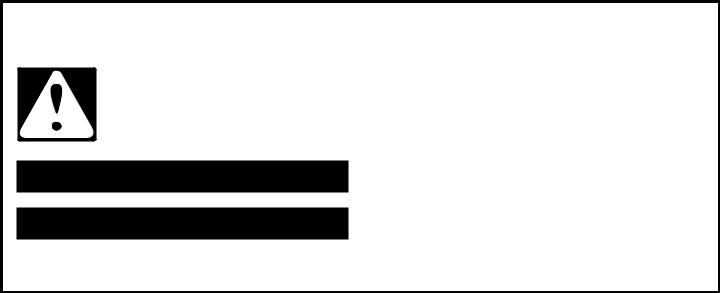
ÍNDICE
SEGURIDAD DE LA LAVADORA 20 ¿QUÉ HAY DE NUEVO DEBAJO DE LA TAPA? 22 PANEL DE CONTROL Y CARACTERÍSTICAS 23 Depósitos 25 GUÍA DE CICLOS 26 USO DE LA LAVADORA 28
MANTENIMIENTO DE LA LAVADORA 31 SOLUCIÓN DE PROBLEMAS 33 CONTRATOS DE PROTECCIÓN 40 GARANTÍA 40 AYUDA O SERVICIO TÉCNICO Contraportada
SEGURIDAD DE LA LAVADORA
Su seguridad y la seguridad de los demás es muy importante.
Hemos incluido muchos mensajes importantes de seguridad en este manual y en su electrodoméstico. Lea y obedezca siempre todos los mensajes de seguridad.
Este es el símbolo de alerta de seguridad.
Este símbolo le llama la atención sobre peligros potenciales que pueden ocasionar la muerte o una lesión a usted y a los demás.
Todos los mensajes de seguridad irán a continuación del símbolo de advertencia de seguridad y de la palabra “PELIGRO” o “ADVERTENCIA”. Estas palabras significan:
 PELIGRO
PELIGRO
 ADVERTENCIA
ADVERTENCIA
Si no sigue las instrucciones de inmediato, usted puede morir o sufrir una lesión grave.
Si no sigue las instrucciones, usted puede morir o sufrir una lesión grave.
Todos los mensajes de seguridad le dirán el peligro potencial, le dirán cómo reducir las posibilidades de sufrir una lesión y lo que puede suceder si no se siguen las instrucciones.
20
